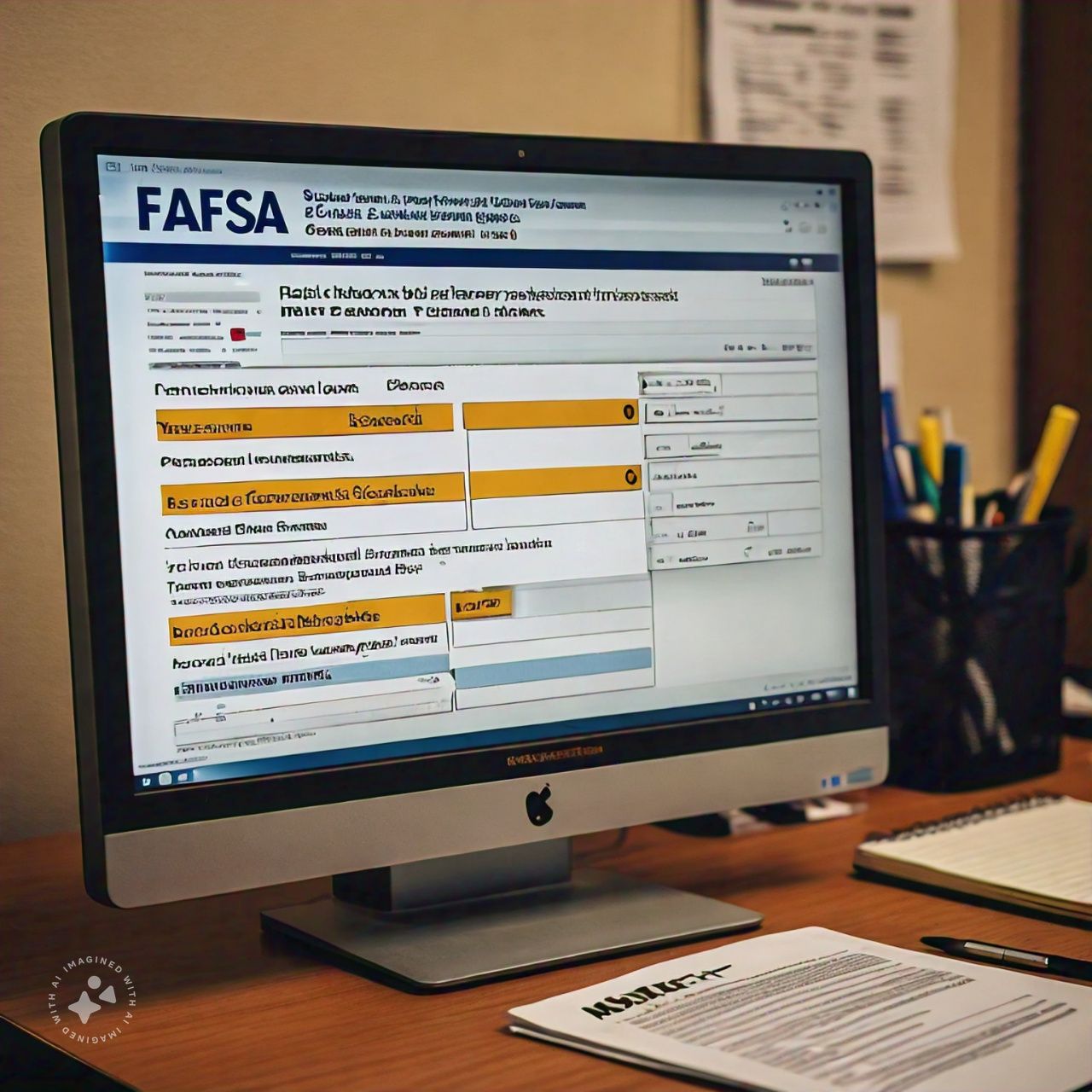
Securing financial assistance for college may seem overwhelming, but having a good grasp of the Free Application for Federal Student Aid (FAFSA) can make the process much simpler. The FAFSA is crucial for accessing different types of financial aid, such as federal grants, loans, and work-study programs. This manual will lead you through the FAFSA procedure, providing advice on optimizing aid and steering clear of common errors.
- University Canada West Scholarships 2024-2025
- Fully Funded Masters Scholarships In Canada For International Students
- Scholarships For Stem Majors 2024-2025
- Fully Funded Scholarships for International Students
Understanding the FAFSA
What is the FAFSA?
The FAFSA form is completed annually by current and potential college students in the United States to assess their qualification for student financial aid, which includes federal grants, work-study, and loans.
How Do I Get Scholarships for College in the USA?
The Weight of Your FAFSA: Why it Matters
Completing the FAFSA is not just a formality; it’s a crucial step. It’s used by the U.S. Department of Education to assess your financial need and determine your eligibility for various types of federal aid. Many states and colleges also use FAFSA data to award their own grants and scholarships.
Step-by-Step Guide to Completing the FAFSA
Step 1: Gather Necessary Documents
Before you start the FAFSA application, gather the following documents:
- Your Social Security number (or Alien Registration number if you are not a U.S. citizen)
- Your federal income tax returns, W-2s, and other records of money earned
- Bank statements and records of investments (if applicable)
- Records of untaxed income (if applicable)
- An FSA ID to sign electronically (create one at fsaid.ed.gov)
Step 2: Create an FSA ID
The FSA ID is a username and password used to access federal student aid websites. Both the student and one parent (for dependent students) will need an FSA ID.
Step 3: Fill Out the FAFSA Form
You can complete the FAFSA online at fafsa.ed.gov, through the myStudentAid mobile app, or by mailing a paper application. The online and mobile forms are recommended for convenience and built-in error checking.
Step 4: Provide Financial Information
Enter your financial information as accurately as possible. If you filed taxes, use the IRS Data Retrieval Tool (DRT) to import your tax information into the FAFSA automatically.
Step 5: List the Schools You Want to Attend
You can list up to 10 schools on the FAFSA form. These schools will receive your financial information and use it to determine your financial aid package.
Step 6: Sign and Submit the FAFSA
Sign the FAFSA with your FSA ID and submit it. If you’re a dependent student, your parent must also sign.
Step 7: Review Your Student Aid Report (SAR)
After submitting the FAFSA, you’ll receive a Student Aid Report (SAR) summarizing your information. Review it carefully for any errors or discrepancies.
Tips to Maximize Your Aid
File Early: The Key to Unlocking Aid
FAFSA applications open on October 1st each year. Many states and colleges have their own deadlines, and some aid is awarded on a first-come, first-served basis. Filing early is not just a suggestion; it’s a strategy that can significantly increase your chances of receiving aid.
Use the IRS Data Retrieval Tool
Using the IRS DRT not only saves time but also reduces the chances of errors, which can delay the processing of your aid application.
Correct Errors Promptly
If you find errors on your SAR, correct them as soon as possible. Mistakes can delay your aid package and reduce the amount of aid you receive.
List Multiple Schools
Listing multiple schools on your FAFSA increases your options. Each school uses the information to create a financial aid package, and comparing these packages can help you make a more informed decision.
Understand Dependency Status
The information you are required to provide is influenced by your dependency status. Dependent students are required to include their parents’ financial information, and this can affect the assistance they receive. If you have special circumstances, reach out to your financial aid office for assistance.
Seek Help If Needed
If you require help or have inquiries, there are numerous resources accessible. You have the option to reach out to the financial aid department at your potential college, utilize the FAFSA hotline, or consult with a high school advisor.
Common Mistakes to Avoid
Missing Deadlines
Each state and college has its own FAFSA deadlines, and missing them can result in lost aid opportunities. Mark these dates on your calendar and file as soon as possible.
Incorrect Information
Double-check all information entered on the FAFSA. Common errors include incorrect Social Security numbers, misspelled names, and incorrect financial data.
Not Using the IRS DRT
Failing to use the IRS DRT can lead to mistakes and delays. Always use the tool if you’re eligible.
Leaving Fields Blank
Never leave any fields blank on the FAFSA. If a question doesn’t apply to you, enter “0” or “not applicable.”
Forgetting to Sign
An unsigned FAFSA is incomplete and will not be processed. Ensure both the student and parent (if applicable) sign the form.
Ignoring Follow-Up Emails
After submitting your FAFSA, you may receive follow-up emails requesting additional information or documentation. Promptly respond to these requests to avoid delays.
Conclusion
Filing the FAFSA is a critical step in securing financial aid for college. By following this step-by-step guide, you can navigate the process with confidence. Remember to file early, provide accurate information, and seek help if needed. With careful attention to detail and timely submission, you can maximize your financial aid and move closer to achieving your educational goals.
By adhering to these guidelines, you’ll be well on your way to completing the FAFSA and obtaining the financial assistance needed for your college education.
FAFSA Application Process: A Quick Overview
The FAFSA (Free Application for Federal Student Aid) process involves several key steps to secure financial aid for college:
- Gather Necessary Documents: Collect your Social Security number, tax returns, W-2s, bank statements, and records of untaxed income.
- Create an FSA ID: Set up a username and password at fsaid.ed.gov for both you and one parent (if dependent).
- Complete the FAFSA Form: Fill out the form online at fafsa.ed.gov, via the myStudentAid mobile app, or by mail.
- Provide Financial Information: Accurately enter your financial details. Use the IRS Data Retrieval Tool (DRT) if possible.
- List Schools: Select up to 10 schools to receive your FAFSA information.
- Sign and Submit: Sign the form electronically with your FSA ID and submit it. Dependent students will need a parent’s signature as well.
- Review Your Student Aid Report (SAR): Check your SAR for any errors and correct them promptly.
Filing the FAFSA early and accurately can maximize your chances of receiving financial aid.
FAQs About the FAFSA Application
1. When should I file the FAFSA?
You should file the FAFSA as soon as possible after October 1st each year. Many states and colleges have their own deadlines, and some aid is awarded on a first-come, first-served basis.
2. Do I need to file the FAFSA every year?
Yes, you need to file the FAFSA every year you are in college to continue receiving financial aid.
3. What if my financial situation changes after I submit the FAFSA?
If your financial situation changes significantly, you should contact the financial aid office at your school to discuss your options and see if your aid package can be adjusted.
4. Do I need my parents’ information to complete the FAFSA?
If you are a dependent student, you will need to provide your parents’ financial information. Independent students will only need to provide their own financial information.
5. What is an FSA ID and why do I need it?
An FSA ID is a username and password that you use to log in to federal student aid websites. It is used to sign your FAFSA electronically. Both the student and one parent (for dependent students) need an FSA ID.
6. How do I know if I qualify as a dependent or independent student?
Dependency status is determined by several questions on the FAFSA about your age, marital status, military service, and other factors. Generally, if you are under 24, not married, and not a veteran, you will be considered a dependent student.
7. What happens after I submit the FAFSA?
After you submit the FAFSA, you will receive a Student Aid Report (SAR) summarizing your information. Review it for errors and make any necessary corrections. The schools you listed will use your FAFSA information to determine your financial aid package.
8. Can I list more than 10 schools on the FAFSA?
Initially, you can list up to 10 schools. If you need to add more, you can submit the FAFSA with the first 10 schools, wait for it to be processed, and then log back in to replace some schools with others.
9. What if I need help filling out the FAFSA?
If you need assistance, you can contact the financial aid office at your prospective college, use the FAFSA helpline, or seek advice from a high school counselor.
10. Is there a fee to file the FAFSA?
No, the FAFSA is free to file. Be wary of any websites or services that charge a fee to submit the FAFSA.
11. What types of financial aid can I receive by completing the FAFSA?
By completing the FAFSA, you may be eligible for federal grants, loans, and work-study programs. Some states and colleges also use FAFSA data to award their own grants and scholarships.
12. Can I correct errors on my FAFSA after I submit it?
Yes, you can log back into your FAFSA account to correct errors or update information. It’s important to make corrections as soon as possible to ensure your financial aid is not delayed.
Read Also:
How to Get into Harvard with a Full Scholarship
How Can I Get a Study Scholarship?
Guide to Study Abroad Scholarships





